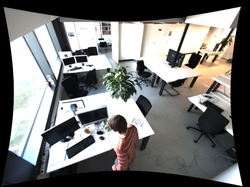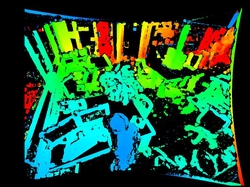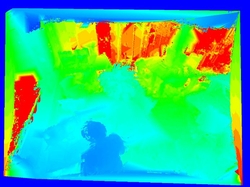Stereo Correspondence
The central challenge in generating 3D data using passive stereo is solving the stereo correspondence problem. To measure 3D scenes using 2D images, either 2 or more cameras are usually recorded at the same time (stereo) or a moving camera is recorded in chronological order (structure-from motion). In order to calculate the depth information, it is necessary to know the corresponding 3D points in the captured images. For this research question, which is called a correspondence problem, there is a large number of solutions in the literature (Middlebury Dataset). However, the majority of these methods focus on optimization with respect to a limited test dataset.
Various methods of stereo correspondence analysis are investigated and developed at the Chair of Digital Signal Processing and Circuit Technology. The goal of the development is the solution of the practical challenges:
- Measurement of high observation volumes (range, viewing angle, high image resolution)
- Generation of dense depth maps with unstructured surface texture
- Unusual lighting conditions
- Real-time implementation on embedded systems
The figures compare a simple method of correspondence analysis (block matching) with a modern method of generating dense depth maps



Publications
| Title | Author(s) | Year | |
|---|---|---|---|
| 1 | A Study on the Influence of Omnidirectional Distortion on CNN-based Stereo Vision
16th International Joint Conference on Computer Vision, Imaging and Computer Graphics Theory and Applications, 08.02.2021 - 10.02.2021, Online-Konferenz, pp. 809-816. - Setúbal, Portugal : SCITEPRESS - Science and Technology Publications, 2021 |
Seuffert, Julian Perez Grassi, Ana Cecilia Scheck, Tobias Hirtz, Gangolf |
2021 |
| 2 | Towards High-Quality 3-D Reconstructions with Omnidirectional Stereo Vision Systems
Biomedical Engineering - Joint Journal of the German Society for Biomedical Engineering in VDE and the Austrian and Swiss Societies for Biomedical Engineering and the German Society of Biomaterials, 25.09.2019-27.09.2019, Frankfurt. - Berlin : Walter de Gruyter. - 64.2019, Heft s2, S143 |
Seuffert, Julian Deshpande, Pavan Krishna Hirtz, Gangolf |
2019 |
| 3 | Ein Neuer Ansatz für Sphärisches Stereo Vision
|
Findeisen, Michel | 2015 |
| 4 | An Omnidirectional Stereo Sensor for Human Behavior Analysis in Complex Indoor Environments
IEEE International Conference on Consumer Electronics (ICCE), 09.01.2015-12.01.2015,Las Vegas, pp. 17-19 |
Findeisen, Michel Meinel, Lars Richter, Julia Hirtz, Gangolf |
2015 |
| 5 | A trinocular omnidirectional stereo vision system for high-precision RGB-D acquisition
ELMAR (ELMAR), 2014 56th International Symposium, 10-12 Sept. 2014, pp. 1 - 4 |
Findeisen, Michel Meinel, Lars Hirtz, Gangolf |
2014 |
| 6 | Trinocular Spherical Stereo Vision for Indoor Surveillance
Canadian Conference on Computer and Robot Vision (CRV), 2014, pp. 364 - 370 |
Findeisen, Michel Hirtz, Gangolf |
2014 |
